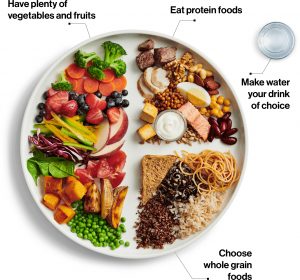Don’t cry over spilt milk! Gone is the rainbow of Canada’s old food guide.
Experts from the Faculty of Health Sciences weigh-in on the pros and cons of Health Canada’s new model from a nutritional and health behaviour standpoint.

The new guide has revised the presentation of the four food groups, notes Dr. Kathy Keiver, adjunct professor in the department of kinesiology, and encourages Canadians to be mindful of eating habits. Cook at home, eat meals with loved ones, limit high sodium, sugar, and unhealthy fat, and focus on loading plates with fresh vegetables and fruit are among the new suggestions. Proteins and whole grains have been added, while dairy, meat and alternatives, and guidance on portion size are removed.
Keiver questions how the public will utilized the change in guidance on portion sizes from specific servings to the new plate model.
“On the one hand, it sounds easy, but on the other, people don’t usually include all those types of foods every time they eat, especially snacks, so I’m not sure how that will play out over the day,” says Keiver. “One thing that the old guide was very good at, if you followed all the messages, was ensuring that you were likely to meet all the recommendations for individual nutrients.”
Dr. David Harper, associate professor in the department of kinesiology at UFV and ketogenic researcher, believes the new guide lacks the macronutrient proportions needed for challenging obesity and chronic disease. “The guide is not meeting requirements for essential fatty acids,” explains Harper. Like Keiver, Harper agrees the new plate model could be missing critical nutritional components to a healthy human diet. From Harper’s perspective, there is too much focus on grains and not enough emphasis on healthy fats.
Across the board, our experts agree that the new food guide lends focus to health behaviours and eating habits. Catherine Smith, an assistant professor in the nursing department, believes the change may prompt Canadians to consider a more sustainable way of eating. While Dr. Iris Lesser, an instructor and researcher in the department of kinesiology, praises the guide for simplicity and focus on eating well.
“Shifting from a portion based diet to a broader sense of how we eat and eating well is a good change for society considering the struggles we have with food and how to consume,” notes Lesser. “With the abundance of information on dieting and quick access to weight-loss, once you start to tell people exactly what to eat, they over think it. The change on emphasizing health behaviours, which is the forefront of eating, is positive and provides people an ability to generally understand how to eat well while leaving room to follow up with a professional if they need specifics tailored to their own health.”
Lesser notes that most of our daily activities incorporate food. “The new guide encourages people to move away from thinking how much meat did I eat today, for example, to a more general focus that matches how we interact with food, where we get our food from, and how we choose to eat it,” says Lesser.
Despite the differences in perspectives on the new recommendations, lack of cultural sensitivity was noted as missing from the guidelines. Our experts are of the opinion that the guide is limited in recognizing how individuals respond to food, as well as cultural and environmental considerations. Harper believes that the recommendation is one-size-fits-all approach, which is contrary to cultural food history, such as Indigenous diets. Lesser adds that eating behaviours are driven by cultural practices. In her research with Fraser Health on South Asian community food choices, she explores how cultural groups can incorporate healthy behaviours while maintaining their traditional food practices.
Accessibility and the social determinants of health could also be a contributing factor in whether or not the new food guide serves the needs of Canadians.
“If you think about the picture of the plate, not everyone will have access to a variety of foods. Proximity to food sources and finances could play a role,” notes Lesser.
“Given the changing demands on people’s time and availability of fast, convenient foods, making food at home or from scratch might not be an option,” says Keiver.
For more information about the new Canadian food guide, click here.

